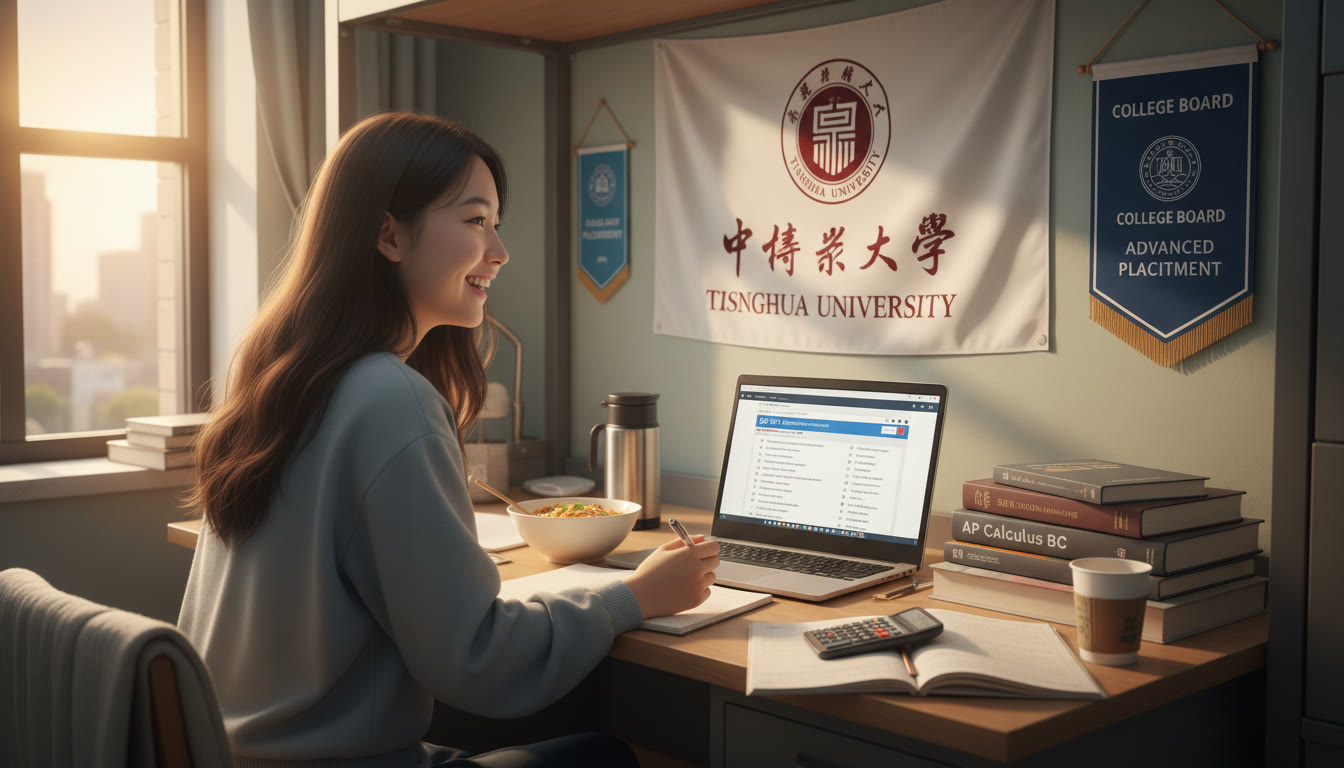Introduction — Why you’re asking about the SAT and Tsinghua
If you’re a student (or parent of a student) aiming for Tsinghua University, you’re juggling a joyful mix of excitement and questions: Does Tsinghua accept SAT scores? How much do SATs matter compared with other parts of the application? What’s the smartest way to prepare for the Digital SAT while compiling the rest of an international application?
This article walks you through these questions with clear, realistic advice. I’ll explain the role of the SAT for international applicants, give practical scoring targets and timeline suggestions, and show how to present a competitive application. Along the way you’ll find examples, a comparison table, and concrete next steps — plus where targeted, one-on-one help (like Sparkl’s personalized tutoring) can make a meaningful difference.
Big-picture: How standardized tests fit into Tsinghua’s admissions for international students
Tsinghua University is one of the most selective universities in the world. For international applicants, admissions committees look for academic excellence, strong evidence of subject mastery, and potential for research or leadership in your intended field. Standardized tests — such as the SAT — may be one component among many. The weight placed on the SAT varies depending on the program, the year, and whether the applicant applies through a special international program or partnership.
Important idea: For many international students, the SAT serves as a common academic benchmark that helps admissions officers compare applicants from diverse schooling systems. In some programs SAT results are optional, in others they may strengthen (or be required for) an application. Because policies evolve, treat this guide as a strategic framework, not a literal checklist. Use it to prepare thoroughly so you can adapt to any specific requirement revealed in an application cycle.
What matters besides the SAT
- Academic transcripts and rigorous course selection (math, sciences, AP/IB/A-level equivalents when available).
- Subject tests or proof of subject proficiency (like AP or IB Higher Level results)—especially for STEM majors.
- Personal statement / essays that show motivation, curiosity, and fit for Tsinghua’s environment.
- Recommendation letters from teachers or mentors who can speak to your academic potential and research or project experience.
- Extracurricular achievements, research projects, competition results (e.g., Olympiads), or internships that demonstrate depth.
- Interview performance, if offered—this is where fit and personality shine.

Does Tsinghua accept the SAT (Digital SAT)?
The short, practical answer: many international applicants submit SAT scores as part of their application materials, and Tsinghua has historically accepted international standardized tests as one avenue to demonstrate academic readiness. However, whether a specific program requires or recommends the SAT can change by admission cycle.
So here’s the smart approach: assume a strong SAT score will help, prepare accordingly, and check the exact requirement for the year and program you plan to apply to. Preparing early keeps you flexible: if SAT submission is optional or unnecessary in a given cycle, a high score still strengthens scholarship or exchange program applications and demonstrates readiness in an objective way.
When SATs are most valuable for Tsinghua applicants
- Applying to undergraduate programs taught in English or international tracks — where admissions committees rely on comparable metrics.
- If your school’s transcript system is unfamiliar to the admissions office, a standardized score helps translate your academic strength.
- When competing for limited seats or merit-based awards, objective test scores can tip a close decision in your favor.
What’s a competitive SAT score for a top-tier international applicant?
Competitive is relative: for a highly selective school like Tsinghua, international applicants should target the upper percentiles of the SAT to be comfortably competitive. That generally means aiming for scores that place you well above average among international applicants to top global universities.
Because the Digital SAT uses a different scale and content emphasis than older versions, prepare with the specific Digital SAT format in mind — practice on official-style digital materials and simulate the testing environment. If you have a specific target major (e.g., Computer Science, Engineering), strong math performance is especially important.
| Goal | Digital SAT Score Range (approx.) | Why |
|---|---|---|
| Minimum competitive | 1200–1350 | Shows solid readiness; may be considered with very strong other materials. |
| Strongly competitive | 1360–1500 | Comfortable for many selective programs; helps stand out among international applicants. |
| Top-tier / standout | 1510–1600 | Exceptional and likely to strengthen an already-strong application for elite engineering or sciences programs. |
Note: These ranges are practical guidance rather than strict cutoffs. Admissions is holistic: a 1450 with exceptional research and recommendations may be stronger than a 1550 with a weaker profile.
How to prepare for the Digital SAT with Tsinghua in mind
Preparation should be strategic, not just time-consuming. The Digital SAT emphasizes problem solving, evidence-based reading, and efficient use of digital tools (e.g., on-screen navigation, digital calculators on certain sections). Combine skills practice with application-focused thinking — align preparation to your intended major and the kind of coursework you’ll encounter at Tsinghua.
Six practical preparation steps
- Start with a diagnostic digital practice test to identify strengths and weaknesses — don’t guess your level.
- Set score goals by section (Math, Reading & Writing) and create a weekly plan with measurable milestones.
- Practice on digital platforms: timed sections, screen reading practice, and the digital interface are all habits that reduce test-day friction.
- Strengthen content gaps with targeted study: focused math topics, critical reading strategies, and concise grammar rules.
- Do full, timed practice tests at least once every 2–3 weeks in the final months to build stamina and timing.
- Use college-targeted practice: frame practice questions around STEM contexts or humanities passages depending on your major.
When to take the test
Plan to complete your final, target-level SAT at least 2–3 months before Tsinghua’s application deadline for international students. This gives you time to retake if necessary and to incorporate the score into other materials (like scholarship applications). If you’re applying early or to programs with early deadlines, adjust earlier.

Beyond scores: Crafting a standout application
Even a perfect SAT won’t be the whole story. Admissions committees at top universities seek students who show intellectual curiosity, initiative, and the potential to contribute academically and culturally. Here’s how to pair test preparation with application-building.
Essays and personal statements
- Focus essays on genuine experiences that shaped your interests — research projects, a competition you led, or a real-world problem you solved.
- Use specific examples: describe a research method you used, what you discovered, and what you learned intellectually.
- Show fit with Tsinghua: mention academic environments or research labs you admire (without generic flattery). Explain how Tsinghua’s approach aligns with your goals.
Recommendations and research experiences
Letters that describe initiative, technical ability, and growth are especially valuable. If you’ve done research or a substantial project, ask your supervisor for a letter that explains your role, the problem you tackled, and the intellectual contribution you made.
Portfolio or interview (if applicable)
Some programs may request interviews or portfolios (e.g., design or architecture). Treat these as additional opportunities to demonstrate depth — prepare a short narrative about your most meaningful work and practice clear technical explanations.
Example application timeline (junior–senior year)
| When | Action |
|---|---|
| Junior year — Fall | Begin diagnostic SAT and set score goals. Start research/project that can be finished by senior year. |
| Junior year — Spring | Take first official Digital SAT (practice + official). Request teacher recommendations and keep building project evidence. |
| Summer between junior & senior | Refine essays, continue research, retake SAT if needed. Begin finalizing list of target programs and note Tsinghua deadlines. |
| Senior year — Early | Finalize application materials, submit any early application items, and ensure test scores are reported. |
| Senior year — By deadline | Submit final application, request transcripts and official test score reporting, prepare for interviews or additional assessments. |
How to present SAT scores when applying to Tsinghua
When you list SAT scores in the application, provide context: indicate your strongest subject areas and note advanced coursework (AP, IB, A-levels). If your school uses a different grading system, briefly annotate your transcript submission to help readers interpret achievement levels.
If you have multiple scores, send the best official score — admissions offices usually accept superscoring or highest-subscore combinations depending on policy. Keep copies of your official reports and be ready to request score reports early to avoid delays.
Practical examples — two applicant profiles
Profile A — STEM-focused applicant
Background: Strong math and physics coursework, national math competition medal, two semesters research with a university lab.
SAT strategy: Aim for 1500+ with especially high Math section. Highlight research in essays and request a recommendation from the project supervisor. Use SAT math questions to demonstrate problem-solving speed and depth in supplemental materials or interviews.
Profile B — Interdisciplinary applicant (humanities + tech)
Background: Passion for digital storytelling, portfolio of multimedia projects, extracurricular coding club leadership.
SAT strategy: Target 1400–1500 balanced score. Essays emphasize projects showing synthesis of computing and humanities. Use SAT Reading & Writing results to support academic readiness for rigorous English-language coursework.
Where targeted tutoring helps — and what to expect from personalized guidance
Many students benefit from focused, personalized tutoring that targets their specific weaknesses, simulates test conditions, and helps translate test performance into admissions strategy. Personalized tutors can:
- Design a tailored study plan with weekly milestones based on your diagnostic results.
- Provide live 1-on-1 instruction on tricky content areas (e.g., advanced algebra, data analysis, dense passages).
- Offer timed practice and realistic digital test simulations to build stamina and digital fluency.
- Integrate SAT strategy with application coaching so your scores and essays tell a cohesive story.
Sparkl’s personalized tutoring—when used naturally as part of a broader application strategy—offers 1-on-1 guidance, tailored study plans, expert tutors, and AI-driven insights that can help you target the exact improvements that move your score and your application forward. Tutors can also help you polish essays so that your academic narrative aligns clearly with the scores you submit.
Common questions families ask
Is the SAT required for Tsinghua?
Not universally. Requirements vary by program and application cycle. Treat the SAT as potentially valuable and confirm program-specific guidelines early.
Can SAT scores compensate for a weaker transcript?
They can help contextualize your academic ability, but they’re rarely a full substitute for evidence of sustained academic rigor. Strong test scores plus an improving transcript and strong recommendations can together create a persuasive case.
How many times should I take the SAT?
Plan for 2–3 attempts depending on your diagnostic and progress. Take your final, target-level test at least 2–3 months before application deadlines to allow for score reporting and potential retakes.
Final checklist for students aiming at Tsinghua
- Confirm the exact test and application requirements for your program and the year you plan to apply.
- Set clear SAT score goals and follow a structured study plan with regular diagnostics.
- Build deep, demonstrable work in your field of interest (research, competitions, projects).
- Collect strong recommendation letters from teachers or mentors who can attest to your academic potential.
- Craft essays that show intellectual curiosity, problem-solving, and fit with Tsinghua’s mission.
- Consider personalized tutoring if you need focused score improvements, application strategy, or help translating achievements into compelling essays; services like Sparkl can provide 1-on-1 guidance and AI-driven insights to tailor your preparation.
Parting encouragement
Aiming for Tsinghua is a bold and exciting goal — one that rewards preparation, authenticity, and persistence. The SAT is a useful tool in your toolkit: it helps translate your academic abilities into a familiar metric for international admissions committees. But it isn’t the only story you’ll tell.
Focus on building a coherent narrative: rigorous coursework, meaningful projects, thoughtful essays, and objective evidence (like SAT scores) that together show you’re ready to contribute. With careful planning, targeted practice, and focused help when needed, you’ll give yourself the best chance to shine.
Need help getting started?
Start with a diagnostic Digital SAT, create a realistic timeline tied to application deadlines, and decide whether personalized, 1-on-1 tutoring would accelerate your progress. If you’d like, we can sketch a sample 12-week study plan tailored to your diagnostic results and academic goals — say what your current score is and your target, and we’ll map out the next steps.













No Comments
Leave a comment Cancel